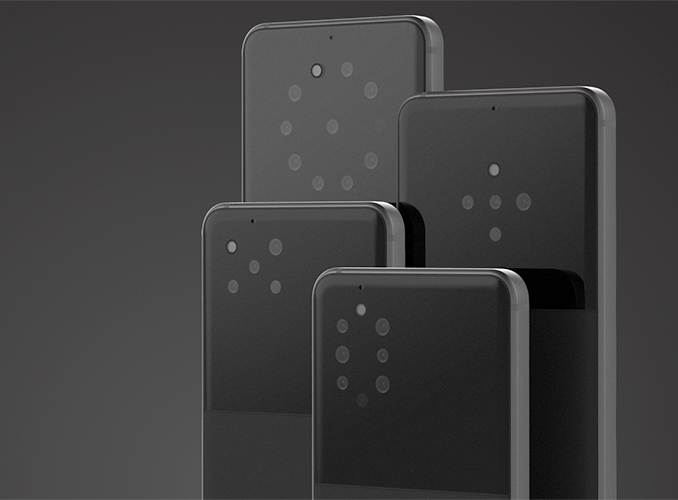Xiaomi Teams Up with Light for Multi-Module Smartphone Cameras
by Anton Shilov on February 27, 2019 4:00 PM EST
Xiaomi and Light, a computational imaging firm, have announced at Mobile World Congress that the two companies will be working together to develop new multi-module cameras for smartphones. The two companies promised that the jointly-developed cameras will feature DSLR-level capabilities, but did not disclose when the first product from the joint project is expected to come to fruition.
Light specializes on computational imaging solutions using multiple camera arrays. The company has gone so far as to develop their own chip that can work with 6, 12, or 18-camera arrays. And while Xiaomi and Light aren't specifying just how big of a camera array they're looking to develop, we're likely looking at something in the lower-bounds of those number, if only due to the limited size of smartphones. For reference's sake, a 6-module camera would be very similar to what Nokia has done for their Nokia 9 PureView.
Light has a custom ASIC chip that independently controls all camera modules to focus them, adjusts exposure levels per aperture, calculates the white balance, etc. After the camera modules capture their images, the ASIC fuses then together into one ‘RAW’ image that contains color and lighting/shadows information. After this part is done, the ASIC transfers the ‘RAW’ image for further processing to an application processor using two MIPI transmitters.
Based on the press release published by Light and Xiaomi, the two companies plan to develop not just one, but a number of imaging solutions for smartphones. So expect to see Light's tech show up in multiple Xiaomi smartphones.
Related Reading:
- Nokia Launches Nokia 9 PureView at MWC 2019: So I Heard You Like Cameras
- Xiaomi Launches The New MIX3 5G and Mi9 for European Markets
- Xiaomi Mi 9 Lauched in China: 6.39-inch Snapdragon 855 with Game Turbo
Sources: Xiaomi, Light










8 Comments
View All Comments
nikon133 - Wednesday, February 27, 2019 - link
Interesting, so... It is Sony and Xiaomi partnering with Light... and Nokia must have, since Nokia 9 should be based on same tech. A new trend? Personally, I'm more keen in seeing this advance, than foldable screens. Having phone that can come close to large sensor cameras - even if only in prime lens configuration (single focal length) would be something to behold.Midwayman - Thursday, February 28, 2019 - link
I'm a little surprised its taken this long. I've been thinking for years that plenoptic cameras are the only real way forward for cell phone cameras, given the depth limitations.boozed - Thursday, February 28, 2019 - link
These aren't plenoptic cameras though, and the technology doesn't exist yet to enable a convenient consumer grade plenoptic camera, let alone one that fits inside a mobile phone.Following the Nokia 9 article, I read a review of Light's own digital camera, the L16. A combination of curiously weird and alarmingly bad performance. It didn't seem to come close to measuring up to its marketing claims.
SydneyBlue120d - Thursday, February 28, 2019 - link
A top of the line model with the Snapdragon 855 successor with integrated X55 modem plus Sony and Light camera configuration could be a must buy!damianrobertjones - Thursday, February 28, 2019 - link
Please, please and please bring back something like the Nokia 1020.alexvoda - Thursday, February 28, 2019 - link
The Nokia Lumia 1020 had: 41 MP, f/2.2, 26mm (wide), 1/1.5", 1.12µm, OIS, AFThe following phones have something similar:
-Xiaomi Mi 9: 48 MP, f/1.8, 1/2", 0.8µm, Laser/PDAF
-vivo V15 Pro: 48 MP, f/1.8, 1/2", 0.8µm, PDAF
-Huawei Mate 20 Pro: 40 MP, f/1.8, 27mm (wide), 1/1.7", PDAF/Laser AF
And at least one of those phones has pixel binning like the Lumia 1020. The Xenon Flash is not coming back though.
Midwayman - Thursday, February 28, 2019 - link
None of those have the sensor size the 1020 did. I'd love to see someone try and work 4/3rd into a phone body. Or the nikon cx format.nikon133 - Thursday, February 28, 2019 - link
I don't think you can put such a large sensor in phone and keep the phone slim... you'd need some space between lens and the sensor. Larger lens, too. Eventually, the only way to do this (that crosses my mind) is to use Motorola's approach and create modular phone with chunky snap-on camera module. Which would not be much more different from carrying phone and pocket camera in a first place.